 OΡΦEOC BAKKIKOC. Del 1
OΡΦEOC BAKKIKOC. Del 1
OΡΦEOC BAKKIKOC. Del 2
OΡΦEOC BAKKIKOC. Del 3
OΡΦEOC BAKKIKOC. Del 4
OΡΦEOC BAKKIKOC. Del 5
OΡΦEOC BAKKIKOC. Del 6
OΡΦEOC BAKKIKOC. Del 7
OΡΦEOC BAKKIKOC. Del 8
OΡΦEOC BAKKIKOC. Del 9
OΡΦEOC BAKKIKOC. Del 10
This is a brief summary in English of my investigation of the small gem or amulet (or whatever it is) that depicts a crucified person and which has an inscription reading OΡΦEOC BAKKIKOC. With the help of Google’s translation services, you could fairly well read the original Swedish blog posts in machine translation into English.
OΡΦEOC BAKKIKOC
PART 1: Background and overview
PART 2: With curved legs from the side
PART 3: The design of the cross
PART 4: Nails and alone
PART 5: The moon and the stars
PART 6: The inscription
PART 7: The positions of the arms and the head
PART 9: Carotta’s theory on the crucified Julius Caesar
PART 10 Documentary on National Geographic
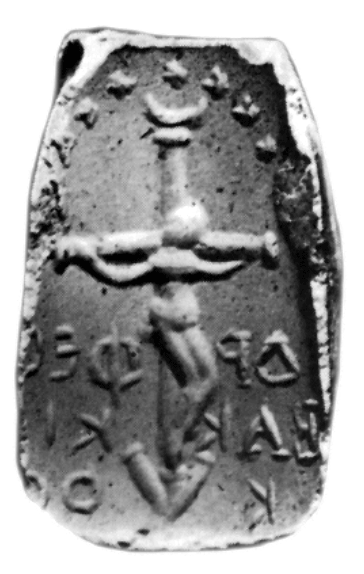 The inscription OΡΦEOC BAKKIKOC should be read as ORPHEOS BAKKIKOS and refers to the mythological Greek musician Orpheus and the Greek wine god Dionysus, whose Roman name was Bacchus. It is not certain how the ”misspelled” words should be interpreted. Perhaps it should be read as the Bacchic or Dionysian Orpheus, therefore, to Orpheus’ glory as the wine drunken Bacchus, or something similar.
The inscription OΡΦEOC BAKKIKOC should be read as ORPHEOS BAKKIKOS and refers to the mythological Greek musician Orpheus and the Greek wine god Dionysus, whose Roman name was Bacchus. It is not certain how the ”misspelled” words should be interpreted. Perhaps it should be read as the Bacchic or Dionysian Orpheus, therefore, to Orpheus’ glory as the wine drunken Bacchus, or something similar.
Two years after the German archaeologist Eduard Gerhard died in 1867, this item was donated to the Kaiser-Friedrich-Museum (now the Bode Museum). Originally it came from Italy. In 1904 the item became part of a permanent exhibition and was there up until World War II, when for some unknown reason it disappeared from the exhibition and has since then been missing. The story and the background are depicted in part 1.
I am not sure that the stone is genuine, but I have long suspected that it is genuine. Now that I have investigated the reasons for why it should be a forgery, I am even more inclined to think that it after all is genuine. It seems like the fundamental reason for the forgery proponents to discard it as a forgery is that they believe that it depicts Jesus; and then they say that Jesus was not depicted that way in ancient time (which is not entirely correct). But why should we believe that the crucified figure is Jesus, when the inscription says something else? This seems to be the case:
1) None of those who have examined the object found anything suspicious in the way the incision was done.
2) The objections were solely based on comparisons made to early depictions of Jesus on the cross.
3) Even though they claimed that there were a number of unique things in the depiction, every one of those so-called unique characteristics are found in other older motives and often also in images of Jesus on the cross. The only things that are missing, like nails through the feet, are also missing on the OΡΦEOC BAKKIKOC-stone.
4) There are at least four other inscriptions saying OΡΦEOC BAKKIKOC or something very similar.
5) The crucified Orpheus is done with hanging arms and the head above the crossbeam, precisely as is done on the earliest depictions of Jesus on the cross.
 A clever forger could of course imitate all these characteristics, but he then would have had to know about these early gems and inscriptions, of which most seem not to have been available before the mid nineteenth century (the earliest possible time for a forgery). And then this clever forger still would have depicted the crucified person slightly from the side and with his knees bent, contrary to most depictions of Jesus on the cross. If you shall forge an item and are an expert who knows how to make the arms and how to position the body (which he knew), why then chose a pose which is quite unusual? A counterfeiter’s most important rule must be to make things as similar as a genuine artifact as possible.
A clever forger could of course imitate all these characteristics, but he then would have had to know about these early gems and inscriptions, of which most seem not to have been available before the mid nineteenth century (the earliest possible time for a forgery). And then this clever forger still would have depicted the crucified person slightly from the side and with his knees bent, contrary to most depictions of Jesus on the cross. If you shall forge an item and are an expert who knows how to make the arms and how to position the body (which he knew), why then chose a pose which is quite unusual? A counterfeiter’s most important rule must be to make things as similar as a genuine artifact as possible.
None of the contemporary experts who examined found anything suspicious in how the incision was done. As Francesco Carotta puts it:
“The cut and its technique are flawless, and connoisseurs of gems like Furtwängler, who described the original in 1896, and Robert Zahn voiced no objections. The latter confirmed that due to the form of the letters the piece could not be dated later than approximately to the third century. It would then belong to the series of early depictions of the Crucifixion on gems.” (Francesco Carotta with Arne Eickenberg, Orpheos Bakkikos: The Missing Cross, Isidorianum, Centro de Estudios Teológicos de Sevilla, 2009, nr 35, p. 4)
The stone is made of hematite, a blood-red ferric oxide. The object is very small, only about 9 x 14 mm and the crucified man reasonably about 6 mm long. As Robert Zahn claimed that the design of the letters (style) was such that the object (if authentic) could not be later than from the third century CE, this reasonably means that it could be older.
 The objections made and to this day are made against its authenticity, are therefore based on the theme and that this is thought to deviate from the way similar items were done in Antiquity. However, one should bear in mind that the comparative material is basically the representations of the crucified Jesus. Since nothing Christian appears in the inscription, which on the contrary refers to Orpheus and Dionysus, all comparisons with Christian objects automatically become part of a circular reasoning.
The objections made and to this day are made against its authenticity, are therefore based on the theme and that this is thought to deviate from the way similar items were done in Antiquity. However, one should bear in mind that the comparative material is basically the representations of the crucified Jesus. Since nothing Christian appears in the inscription, which on the contrary refers to Orpheus and Dionysus, all comparisons with Christian objects automatically become part of a circular reasoning.
1) The first objection made is that the crucified person is depicted with his feet on top of each other.
That this is the case is however difficult to say, because of the low resolution images preserved of the tiny figure.
 2) The crucified figure is depicted with his knees bent, in a way not evidenced anywhere else before the thirteenth century and in this particular style not until the fourteenth century.
2) The crucified figure is depicted with his knees bent, in a way not evidenced anywhere else before the thirteenth century and in this particular style not until the fourteenth century.
And
3) The crucified is depicted at an angle and not from the front.
I deal with all these three objections in part 2. In the earliest depictions of Jesus on the cross also he is depicted from the side and with his knees bent.
4) Zahn argues that in the oldest depictions, the door of Santa Sabina and the ivory plates (both from the fifth century), Jesus stands on a footrest while no footrest appears on the stone depicting ORPHEOS BAKKIKOS.
Yet there is no footrest on the ivory plate either; and on the Santa Sabina-door Jesus is rather depicted as standing on the frame surrounding the image than on a footrest. This is shown in part 3.
5) Zahn also claims that the crosses on these fifth century reproductions are almost completely hidden, and that the vertical poles are not sticking up above the head.
and
6) It is also alleged that the cross on the ORPHEOS BAKKIKOS -stone is Latin (that is, with the upper vertical and two horizontal beams of equal length) while the typical Christian cross before 500 CE was a T-shaped cross.
Both these objections are also dealt with in part 3. Also, Jesus is depicted as crucified on a Latin cross with the vertical pole sticking up behind and above his head.
 In this way the crucified Orpheus / Dionysus-image does not differ from the other early depictions showing Jesus on the cross.
In this way the crucified Orpheus / Dionysus-image does not differ from the other early depictions showing Jesus on the cross.
7) Reil suggests that the crucified figure on the ORPHEOS BAKKIKOS-stone has been nailed through the feet, something not present in earlier images.
But there are no nails going through the feet. Reil just suggested that the two lower beams should be interpreted as nails, which of course is not the case.
8) It is unknown in Antiquity that a crucified person is depicted alone without any supporters.
But as is shown in part 4, this is not true. First of all, it is not valid to compare the crucified Jesus, who often is depicted together with his disciples, with the crucified Orpheus. Secondly, also Jesus is depicted alone.
9) The moon and the seven stars appearing above the crucified can be seen as a later Christian development from the idea that the sun according to the Gospels was darkened when Jesus hung on the cross.
But this is a valid objection only if the figure on the ORPHEOS BAKKIKOS-stone is Jesus. And as he most probably is not, we need to check for this conception among non-Christian notions in Antiquity. As I show in part 5, the moon and stars are fully consistent with the cult of the Emperors and the Graeco-Roman religion.
In part 6 I showed that the there are other examples with the inscription OΡΦEOC BAKKIKOS.
In part 7, I showed that the depiction of the crucified Dionysian Orpheus with his arms “tied” to the crossbeam, his elbows bent and his head above the crossbeam, is exactly how Jesus was depicted in the earliest preserved images. So is also the case with the two oldest graffiti with crucified figures.
So all in all, the image of the crucified Dionysian Orpheus is fully consistent with other ancient images of Jesus and others on the cross.
There is a hole going right through the stone and through which you could bring a thread and make it into an item to wear around your neck. It could then originally have been a pendant or a gem. Still it might have been used as an amulet. Yet, the hole could also have been made afterwards, in a similar way as it in modern times has become popular to drill holes through coins and wear them in a thread around your neck.
Then there is the possibility presented by Francesco Carotta, that it is a crucifixum signum on the apex of the high priest of the deified Julius Caesar, which has been preserved on the Papal and Patriarchal headdresses. It would then have been part of the cult of Divus Iulius, which commenced as the Roman imperial religion in 44 BCE.
In a coming post I will present this proposal by Carotta more in detail. It can be found here,
Roger Viklund
2011-05-07
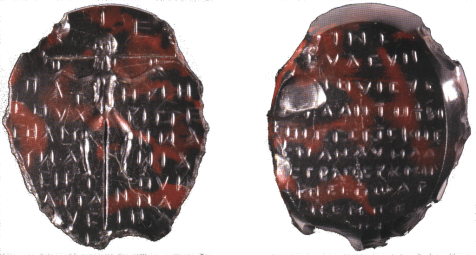
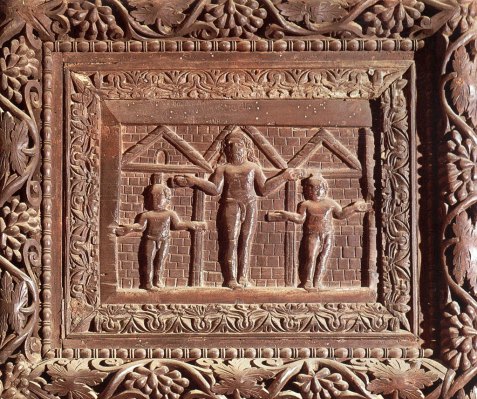
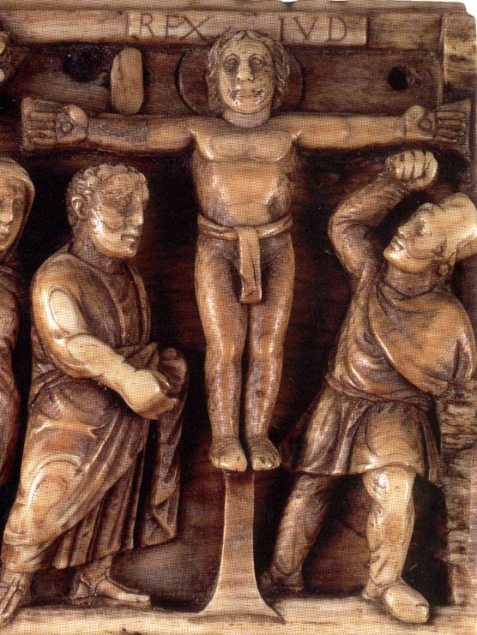
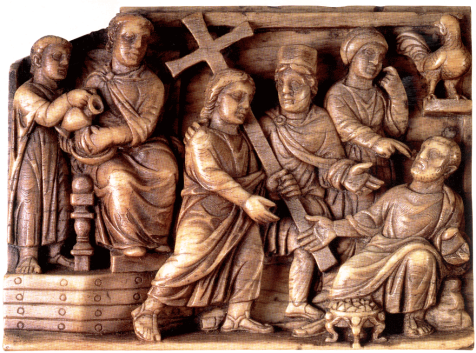






Physical Evidence of Early Christianity » Peter Kirby said,
19 december, 2013 den 01:54
[…] … kos_en.pdf http://ifpeakoilwerenoobject.blogspot.c … art-2.html https://rogerviklund.wordpress.com/2011/ … n-english/ http://bedejournal.blogspot.com/2004/07 … ified.html http://hypotyposeis.org/weblog/2006/08/ […]
GillaGilla
Bernard Bel said,
25 oktober, 2021 den 12:16
Dear Roger,
I would like to cite this blog article in a book that I am in the process of translating. However, all links are inactive because they point at a ”502” error… Can you restore them?
Thank you for this very interesting work!
GillaGilla
Bernard Bel said,
25 oktober, 2021 den 13:08
More about this: Do you allow us to reproduce picture ”orefusbakkikos3.png” and include a link to this article?
GillaGilla
Roger Viklund said,
26 oktober, 2021 den 09:24
Of course, you can cite the blog article and the links are now restored. I have no objections to you reproducing orefusbakkikos3.png, however I don’t hold the copyright of the image. It is taken from Carotta’s article here: https://www.carotta.de/subseite/texte/articula/Orpheos_Bakkikos_en.pdf
GillaGilla
Bernard Bel said,
26 oktober, 2021 den 11:31
Thank you Roger! Also for the English version of Carotta’s paper, which I had only found in German so far…
GillaGilla